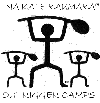
THE HANA HOU SERIES Flipping (and pointing a finger) © 1999 Kawika Sands |

THE HANA HOU SERIES Flipping (and pointing a finger) © 1999 Kawika Sands |
|
There you are, skimming right along without a care in the world except for
the water near the canoe. You reach for the water again when you somehow
notice it seems higher on one side than the other. By the time you feel
your seat tilting, you catch a glimpse of the ama when something tells
you... "It ain't comin' down any time soon!" SPLASH!
What usually happens next is a lot of finger-pointing. This examines the assignability of "blame" when it comes to a luma`i (capsize. Otherwise referred to inaccurately as a "huli"). In the long run, it doesn't really matter what the circumstances are. Everyone almost instinctively looks at the steersman. In light of all the other things he/she must assume responsibility for, this might seem unfair, but it's part of being a backseat driver. For starters, here's how I generally see it:
The first thing you notice here is blame is shared by the crew. Then, that #5 has the next largest share. I assign some responsibility among the crew because they can collectively both help cause a luma`i or prevent it. By paddling incorrectly or on the wrong side, it makes the steersman's job more difficult. Perhaps causing him to steer more on one side or even too late. However, with good training and practice, a strong even stroke along the canoe can perhaps even allow the steersman to "fly" the ama therefor decreasing drag. If a quick maneuver by the steersman is required, without speaking a word, the crew may be able to compensate. You might notice that I've assigned #2 and #4 only slightly more "blame." More because without a "huli" line (a line attached from the forward `iako to the aft `iako), these two paddlers are in the best position to place a hand on the `iako and lean left to counter the ama's momentum. On the other hand, their primary job (like #1 and #3) is to move the canoe. #5 and #6 are supposed to keep it afloat. As if #5 doesn't already have enough to do, his nick-name is "Keeper of the Ama." This is in reference to the facet that he is in the best position to keep an eye on the ama and call for assistance to keep it down. He is closest to the steersman and can be easily warned of quick changes in direction (particularly toward the right). But most important is that #5 should have steering experience. This experience helps him anticipate and coordinate with the steersman. And finally, the steersman. In a way, the most under appreciated seat in the boat (until you sit there) but a high-profile one. The person who sits there should have a sure hand, a clear mind, a command presence, and a thick skin! Whether flat water or open ocean, the crew has to trust what's going on in the back. Each time a steersman proves himself, that trust grows into respect. That trust/respect is what will keep the team together in a crisis, but then, it's a two-way street. The thick skin is priceless when things don't go as planned! One note, the 50% formula I suggested above is merely a starting point. If conditions are particularly tricky, if a paddler strokes on the muku side when he should be on the ama side, if 5 is not watching the ama or has not come to the point where he knows (without being told) when to stroke/lean/poke on the left or shout "AMA" in time, etc., then yes, it is fair to place LESS responsibility on the steersman for a capsize. On the other hand, learning how to read the sea and other conditions, strategy/tactics, maneuvering, and so on are the steersman's responsibility. A good number 5 (and 1 through 4) can make an INCREDIBLE difference.
|

Last Modified: Saturday - 19991113.12:36 EST
Copyright © 1999 Kawika Sands
Produced online by HoloHolo Internet Publishing all rights reserved